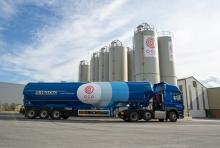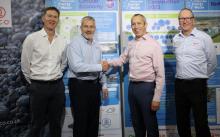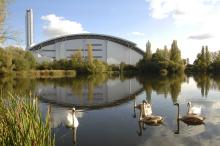O.C.O Technology is eyeing big growth for its highly innovative carbon-negative aggregate product utilising patented and state-of-the-art Accelerated Carbonation Technology (ACT). The company’s waste carbon dioxide capture solution is also attracting strong interest from firms looking for a more eco-minded approach to landfill waste disposal. Guy Woodford, editor of our sister title Aggregates Business, spoke to Steve Greig, the company’s managing director, at O.C.O Technology’s Leeds, North-West England, facility to find out more.
Landing a contract that will see air pollution control residues (APCr) arising from a new energy-from-waste station turned into 75,000 tonnes of high-quality carbon-negative aggregate every year for ten years is a pretty good way to advertise the renaming of a business.
The news of O.C.O Technology’s (O.C.O) agreement with Ferrybridge Multifuel 2 (FM2), a 50-50 joint venture between SSE and Wheelabrator Technologies, in Knottingley, West Yorkshire, came just a month after the carbon-negative aggregates specialist changed its name from Carbon8 Aggregates.
The move also led to a name change for the firm’s award-winning aggregate, previously known as C8Agg, to M-LS (short for Manufactured LimeStone).
O.C.O treats the APCr using its Accelerated Carbonation Technology (ACT), whereby carbon dioxide reacts with the residues and through the addition of various binders and fillers creates the firm’s M-LS carbon-negative aggregate product. A global first, M-LS manufactured limestone has many applications in construction, notably as an ingredient for use in the production of concrete building blocks. It can also be used in precast and ready-mixed concrete, screeds pipe bedding and various road applications.
Expected to be commissioned by the end of 2019, FM2 power station will export in excess of 80MW (gross) / 73.5MW (net) of electricity to the local power network. The contract with O.C.O will ensure that up to 30,000 tonnes per year of the APCr is recycled, permanently capturing around 3,000 tonnes of carbon dioxide. It means that FM2 will be a ‘zero to landfill’ site, fulfilling SSE and Wheelabrator sustainability goals for this station.
The 75,000 tonnes of manufactured limestone produced annually will also help preserve natural resources, with significant environmental benefits.
With the addition of the FM2 contract, O.C.O will be producing over 450,000 tonnes of M-LS aggregates a year at its three plants – Leeds; Avonmouth, near Bristol; and Brandon in Suffolk.
“What we will be able to do with the FM2 contract is continue to show energy from waste plant operators and local authorities that award contracts to them that we are helping the energy waste journey towards 100% recycling,” explains Steve Greig, managing director. “A tonne of APCr going through our process turns out, broadly, 2.5 to 3 tonnes of aggregate. And for every tonne of carbon-negative aggregate used, 1.4 tonnes of natural aggregates are saved. The latter figure is based on the lower density per cube [1100kg/m³] of our M-LS.”
Stressing the difference between M-LS and traditional aggregate products, Greig says: “When you excavate or mine aggregate from a quarry, the product is what it is. Through our production process we rigorously test our aggregate for two aspects: is it chemically okay, and is it fit for purpose? We use our own laboratories and external accredited labs. We stress to our customers that because we manufacture an aggregate, we can make it different. We can make it harder, stronger, bigger or a different colour. We can almost make it whatever you want.
“We can be competitive on price. We also don’t have an Aggregates Levy to contend with. All our customers are large, sometimes national businesses. We never wanted to sell our aggregate by the tonne to the local market. It was all about having relationships with the large players. It is a recycled aggregate and we need to be conscious of the fact that like other recycled aggregates it can’t just go anywhere.”
O.C.O Technology’s spherical M-LS carbon aggregates are sold in sizes of 50mm down to 1mm, with the most popular sizes being 15mm downwards. “Our aggregates look like different-sized peas and customers generally want a grading to help create voids. This, together with the fact that we produce a lightweight aggregate helps in making the concrete product lighter, which has a number of structural and transportation benefits.”
Currently a £13 million-turnover business employing more than 90 staff, the company’s expanding customer portfolio means a fourth UK plant will be in construction soon. O.C.O Technology’s Leeds and Avonmouth facilities also have room to grow, and Greig expects company employee numbers to increase to 150-200 in the next three to five years.
“We currently recycle around 24% of the UK’s energy-from-waste sector’s APCr, and no-one else is doing what we do,” stresses Greig. “That creates a big growth market. The energy-from-waste sector APCr market is growing and our ambition is to treat around 250,000 tonnes of APCr per annum, producing over 700,000 tonnes of aggregate per year in the next three to five years.
“We formed in 2010 as Carbon8 Aggregates specifically to look at APCr as a waste stream to see if we could take what was then a lab-based technology [ACT] and turn it into a commercial entity. We did a bunch of trials and tests to see if it would work. A significant achievement was when we achieved the UK Environment Agency ‘end of waste’ status at the end of 2011. We were the first company in Europe to achieve this status for an APCr waste stream. This demonstrated our credibility in the marketplace.”
Carbon8 Aggregates built its first plant in Brandon in 2012 due to its proximity to Lignacite, a concrete building blocks maker with whom the firm had formed a close working relationship during its initial ACT-testing programme.
“Brandon was the prototype to build Avonmouth in 2015,” explains Greig. “The reason we chose Avonmouth was because there were a lot of energy-from-waste businesses in that area. There were also a lot of concrete building block makers in that part of the west of England. Strategically, it made sense.”
Carbon8 Aggregates then signed a framework agreement with Somerset-headquartered Viridor, one of the UK's leading recycling, resource and waste management companies, to take all their APCr from their plants in Cardiff, Exeter, Ardley, Peterborough and Runcorn.
What was Carbon8 Aggregates’, now O.C.O Technology’s, state-of-the-art Leeds site was opened in 2018.
Greig, who lives in Kent, South-East England, continues: “The ambition for our business was always to build it on the back of recycling APCr as a waste stream. We would then look to expand and incorporate recycling of various other waste streams, such as cement and lime kiln dust, steel slags and other thermal residues creating a UK business that was strong and stable which could give us the platform to look at opportunities overseas.
“Some of the things we are now looking at are not about aggregates, more around pre-treatment prior to landfill. This has led to our change of name to reflect what we are truly about - two oxygens and a carbon. We believe we are the pre-eminent company in using carbon dioxide for industrial waste recycling, and this is an opportunity before establishing ourselves on an international stage to create a brand that reflects our broader offer.”
In May 2020, O.C.O Technology and its new licensed Japanese distributor will open a demonstration plant in Japan to showcase its ACT technology to energy-from-waste companies keen to find a permanent APCr carbon dioxide capture solution prior to the waste’s disposal in landfill. Greig is excited about the massive growth potential for his company in the Japanese marketplace.
“In the UK there are about 50 energy-from-waste plants. This will probably swell to mid-sixties to 70 plants by the time the market build-out has finished. Japan has north of 1,200 energy-from-waste plants, but a lot of them are principality- or local authority-led, so they tend to be a lot smaller. Each principality or local authority has to deal with their own energy waste stream, so our challenge is can we build a suitable in-line plant solution for them?
“There are other opportunities when it comes to recycling Japanese waste streams. For example, the country is still building coal fire power stations. These bring with them lots of challenges in terms of waste stream disposal and how best to gain carbon credits, and huge opportunities for us.
“We are already in the top ten companies in the world for carbon capture. Our ACT technology not only permanently captures the carbon dioxide, it also removes the need for other more expensive treatment layers that would be used to treat waste prior to it going into landfill.”
O.C.O Technology also has sights on the Australian market. “Australia is building its first energy from waste plant. It’s in Perth, Western Australia. There are many more plants planned as they start on their energy from waste journey. It’s a very interesting market for us,” explains Greig.
“We have entered into an agreement for our ACT Technology with Macquarie, a leading investment business with an ambition to be one of the leading energy-from-waste operators in Australia. Wheelabrator Technologies in the UK is part of the Macquarie portfolio. It’s a business that is investing in the energy-from-waste sector worldwide.”
Greig says O.C.O Technology’s research and development team is looking at how the firm can increase the value of M-LS, such as through its potential use in various foam- and traditional-based asphalts and whether it can be produced in different colours in a resin-based format, making it well-suited for use in residential and industrial driveways. “We are also testing M-LS in green [garden centre/nursery/greenhouse] roofing as it retains water which can subsequently be used on plants. With M-LS being lighter, it also means the structure for making your roof does not have to be as heavy. All this could create different income streams and the ambition is to create different branded M-LS such as M-LS – Block Mix and M-LS – Coloured Aggregates.”
A former senior banking and corporate finance executive, Greig was intrigued by the commercial potential for what was then a lab-based technology when helping a client sell his business in 2008. “Part of his business had planning permission for an energy-from-waste plant, and part of the process you go through when seeking planning permission is specifying what you plan to do with APCr residues. Some work had been done and it turned out that a spin-out company from the University of Greenwich, called Carbon8, had been looking to exploit this technology as an alternative to landfill.
“A few years later I was approached to assist in funding this technology. Initially I assisted in arranging angel investment [affluent individual/s who provide capital for a business start-up, usually in exchange for convertible debt or ownership equity] and thought this was quite interesting technology. We did some trials but recognised that it needed more funding and commercial acumen if it was going to be successful. I went home and spoke to my wife and decided to give up my corporate salary and car and invest in Carbon8. I knew I wouldn’t be paid for several years, but I felt it was the right time. I was 40-years-old and had always wanted to run my own business.”
Greig admits he and the rest of the O.C.O Technology management team have been on a “huge learning curve” over the last decade. “It’s been a fantastic journey, which is moving quicker and faster now than it’s ever done, supported by our primary investor Grundon Waste Management Ltd, who have been a fantastic partner. It’s good to be growing a business that is both sustainable and good for the planet. Without doubt, the drive towards a carbon-neutral footprint will have a huge impact on the construction industry in every shape and form.”







